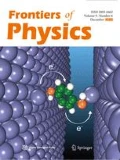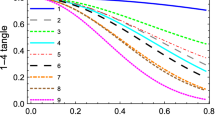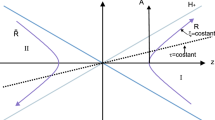Abstract
Using the single-mode approximation, we first calculate entanglement measures such as negativity (1–3 and 1–1 tangles) and von Neumann entropy for a tetrapartite W-Class system in noninertial frame and then analyze the whole entanglement measures, the residual π4 and geometric Π4 average of tangles. Notice that the difference between π4 and Π4 is very small or disappears with the increasing accelerated observers. The entanglement properties are compared among the different cases from one accelerated observer to four accelerated observers. The results show that there still exists entanglement for the complete system even when acceleration r tends to infinity. The degree of entanglement is disappeared for the 1–1 tangle case when the acceleration r > 0.472473. We reexamine the Unruh effect in noninertial frames. It is shown that the entanglement system in which only one qubit is accelerated is more robust than those entangled systems in which two or three or four qubits are accelerated. It is also found that the von Neumann entropy S of the total system always increases with the increasing accelerated observers, but the Sκξ and Sκζδ with two and three involved noninertial qubits first increases and then decreases with the acceleration parameter r, but they are equal to constants 1 and 0.811278 respectively for zero involved noninertial qubit.
Similar content being viewed by others
References
A. Einstein, B. Podolsky, and N. Rosen, Can quantum-mechanical description of physical reality be considered complete? Phys. Rev. 47(10), 777 (1935)
E. Schrödinger, Discussion of probability relations between separated systems, Math. Proc. Camb. Philos. Soc. 31(4), 555 (1935)
E. Schrödinger, Die gegenwärtige Situation in der Quantenmechanik, Naturwissenschaften 23(48), 807 (1935)
E. Schrödinger, Probability relations between separated systems, Math. Proc. Camb. Philos. Soc. 32(3), 446 (1936)
R. F. Werner, Quantum states with Einstein-Podolsky-Rosen correlations admitting a hidden-variable model, Phys. Rev. A 54(8), 4277 (1989)
R. Horodecki, P. Horodecki, M. Horodecki, and K. Horodecki, Quantum entanglement, Rev. Mod. Phys. 81(2), 865 (2009)
O. Gühne and G. Tóth, Entanglement detection, Phys. Rep. 474, 1 (2009)
J. S. Bell, Speakable and Unspeakable in Quantum Mechanics, Cambridge University Press, Cambridge, 1987
A. Peres, Separability Criterion for density matrices, Phys. Rev. Lett. 77(8), 1413 (1996)
K. Życzkowski, P. Horodecki, A. Sanpera, and M. Lewenstein, Volume of the set of separable states, Phys. Rev. A 58(2), 883 (1998)
Y. Li, C. Liu, Q. Wang, H. Zhang, and L. Hu, Tetrapartite entanglement of fermionic systems in noninertial frames, Optik (Stuttg.) 127(20), 9788 (2016)
V. Vedral, M. B. Plenio, M. A. Rippin, and P. L. Knight, Quantifying Entanglement, Phys. Rev. Lett. 78(12), 2275 (1997)
V. Vedral and M. B. Plenio, Entanglement measures and purification procedures, Phys. Rev. A 57(3), 1619 (1998)
V. Vedral, M. B. Plenio, K. Jacobs, and P. L. Knight, Statistical inference, distinguishability of quantum states, and quantum entanglement, Phys. Rev. A 56(6), 4452 (1997)
M. Murao, M. B. Plenio, S. Popescu, V. Vedral, and P. L. Knight, Multiparticle entanglement purification protocols, Phys. Rev. A 57(6), R4075 (1998)
W. Dür, J. I. Cirac, and R. Tarrach, Separability and distillability of multiparticle quantum systems, Phys. Rev. Lett. 83(17), 3562 (1999)
C. H. Bennett, D. P. DiVincenzo, T. Mor, P. W. Shor, J. A. Smolin, and B. M. Terhal, Unextendible product bases and bound entanglement, Phys. Rev. Lett. 82(26), 5385 (1999)
K. Modi, A. Brodutch, H. Cable, T. Paterek, and V. Vedral, The classical-quantum boundary for correlations: Discord and related measures, Rev. Mod. Phys. 84(4), 1655 (2012)
P. M. Alsing, I. Fuentes-Schuller, R. B. Mann, and T. E. Tessier, Entanglement of Dirac fields in noninertial frames, Phys. Rev. A 74(3), 032326 (2006)
M. Montero, J. León, and E. Martín-Martínez, Fermionic entanglement extinction in noninertial frames, Phys. Rev. A 84(4), 042320 (2011)
M. Shamirzaie, B. N. Esfahani, and M. Soltani, Tripartite entanglements in noninertial frames, Int. J. Theor. Phys. 51(3), 787 (2012)
N. Metwally, Usefulness classes of traveling entangled channels in noninertial frames, Int. J. Mod. Phys. B 27(28), 1350155 (2013)
C. H. Bennett, G. Brassard, C. Crépeau, R. Jozsa, A. Peres, and W. K. Wootters, Teleporting an unknown quantum state via dual classical and Einstein-Podolsky-Rosen channels, Phys. Rev. Lett. 70(13), 1895 (1993)
E. Bernstein and U. Vazirani, Quantum complexity theory, SIAM J. Comput. 26(5), 1411 (1997)
D. Bouwmeester, A. Ekert, and A. Zeilinger, The Physics of Quantum Information, Springer-Verlag, Berlin, 2000
N. Gisin, G. Ribordy, W. Tittel, and H. Zbinden, Quantum cryptography, Rev. Mod. Phys. 74(1), 145 (2002)
B. M. Terhal, Is entanglement monogamous? IBM J. Res. Develop. 48(1), 71 (2004)
A. Sen De and U. Sen, Quantum advantage in communication networks, Phys. News 40(4), 17 (2010)
P. Y. Xiong, X. T. Yu, H. T. Zhan, and Z. C. Zhang, Multiple teleportation via partially entangled GHZ state, Front. Phys. 11(4), 110303 (2016)
P. Y. Xiong, X. T. Yu, Z. C. Zhang, H. T. Zhan, and J. Y. Hua, Routing protocol for wireless quantum multi-hop mesh backbone network based on partially entangled GHZ state, Front. Phys. 12(4), 120302 (2017)
K. Wang, X. T. Yu, and Z. C. Zhang, Two-qubit entangled state teleportation via optimal POVM and partially entangled GHZ state, Front. Phys. 13(5), 130320 (2018)
R. Raussendorf and H. J. Briegel, A one-way quantum computer, Phys. Rev. Lett. 86, 5188 (2001)
H. J. Briegel, D. E. Browne, W. Dür, R. Raussendorf, and M. Van den Nest, Measurement-based quantum computation, Nat. Phys. 5, 19 (2009)
M. R. Hwang, D. Park, and E. Jung, Tripartite entanglement in a noninertial frame, Phys. Rev. A 83, 012111 (2011)
J. Wang and J. Jing, Multipartite entanglement of fermionic systems in noninertial frames, Phys. Rev. A 83, 022314 (2011)
Y. C. Ou and H. Fan, Monogamy inequality in terms of negativity for three-qubit states, Phys. Rev. A 75, 062308 (2007)
R. A. Horn and C. R. Johnson, Matrix Analysis, Cambridge University Press, New York, 1985, p. 205, 415, 441
S. Gartzke and A. Osterloh, Generalized W state of four qubits with exclusively the three-tangle, Phys. Rev. A 98(5), 052307 (2018)
D. K. Park, Tripartite entanglement dynamics in the presence of Markovian or non-Markovian environment, Quantum Inform. Process. 15(8), 3189 (2016)
A. J. Torres-Arenas, Q. Dong, G. H. Sun, W. C. Qiang, and S. H. Dong, Entanglement measures of W-state in noninertial frames, Phys. Lett. B 789, 93 (2019)
X. H. Peng and D. Suter, Spin qubits for quantum simulations, Front. Phys. China 5(1), 1 (2010)
S. Takagi, Vacuum noise and stress induced by uniform acceleration, Prog. Theor. Phys. Suppl. 88, 1 (1986)
E. Martín-Martínez, L. J. Garay, and J. León, Unveiling quantum entanglement degradation near a Schwarzschild black hole, Phys. Rev. D 82(6), 064006 (2010)
E. Martín-Martínez, L. J. Garay, and J. León, Quantum entanglement produced in the formation of a black hole, Phys. Rev. D 82(6), 064028 (2010)
W. Dür, G. Vidal, and J. I. Cirac, Three qubits can be entangled in two inequivalent ways, Phys. Rev. A 62(6), 062314 (2000)
M. Socolovsky, Rindler space and Unruh effect, arXiv: 1304.2833v2 [gr-qc]
M. Nakahara, Y. Wan, and Y. Sasaki, Diversities in Quantum Computation and Quantum Information, World Scientific, Singapore, 2013
N. D. Birrel and P. C. W. Davies, Quantum Fields in Curved Space, Cambridge University, Cambridge, England, 1982
A. Smith and R. B. Mann, Persistence of tripartite non-locality for noninertial observers, Phys. Rev. A 86(1), 012306 (2012)
W. C. Qiang, G. H. Sun, Q. Dong, and S. H. Dong, Genuine multipartite concurrence for entanglement of Dirac fields in noninertial frames, Phys. Rev. A 98(2), 022320 (2018)
W. C. Qiang and L. Zhang, Geometric measure of quantum discord for entanglement of Dirac fields in noninertial frames, Phys. Lett. B 742, 383 (2015)
Q. Dong, A. J. Torres-Arenas, G. H. Sun, W. C. Qiang, and S. H. Dong, Entanglement measures of a new type pseudo-pure state in accelerated frames, Front. Phys. 14(2), 21603 (2019)
H. Mehri-Dehnavi, B. Mirza, H. Mohammadzadeh, and R. Rahimi, Pseudo-entanglement evaluated in noninertial frames, Ann. Phys. 326(5), 1320 (2011)
D. E. Bruschi, J. Louko, E. Martín-Martínez, A. Dragan, and I. Fuentes, Unruh effect in quantum information beyond the single-mode approximation, Phys. Rev. A 82(4), 042332 (2010)
E. Martín-Martínez, D. Hosler, and M. Montero, Fundamental limitations to information transfer in accelerated frames, Phys. Rev. A 86(6), 062307 (2012)
N. Friis, A. R. Lee, and D. E. Bruschi, Fermionic-mode entanglement in quantum information, Phys. Rev. A 87(2), 022338 (2013)
A. Dragan, J. Doukas, E. Martín-Martínez, and D. E. Bruschi, Localized projective measurement of a quantum field in non-inertial frames, Class. Quantum Gravity 30(23), 235006 (2013)
J. Doukas, E. G. Brown, A. Dragan, and R. B. Mann, Entanglement and discord: Accelerated observations of local and global modes, Phys. Rev. A 87(1), 012306 (2013)
A. Dragan, J. Doukas, and E. Martín-Martínez, Localized detection of quantum entanglement through the event horizon, Phys. Rev. A 87(5), 052326 (2013)
C. P. Williams, Explorations in Quantum Computing, Springer Science and Business Media, New York, 2010
D. S. Oliveira and R. V. Ramos, Residual entanglement with negativity for pure four-qubit quantum states, Quantum Inform. Process. 9(4), 497 (2010)
C. Sabín and G. García-Alcaine, A classification of entanglement in three-qubit systems, Eur. Phys. J. D 48(3), 435 (2008)
J. von Neumann, Mathematical Foundations of Quantum Mechanics, Princeton University Press, New Jersey, 1996
B. Lari and H. Hassanabadi, Thermal entanglement, specific heat and quantum discord in open quantum systems including non-markovian processes, Mod. Phys. Lett. A 34(11), 1950059 (2019), arXiv: 1704.02811
W. S. Chung and H. Hassanabadi, Black hole temperature and Unruh effect from the extended uncertainty principle, Phys. Lett. B 793, 451 (2019)
Acknowledgements
We thank the referees for making invaluable suggestions. This work was partially supported by the CONACYT, Mexico under the Grant No. 288856-CB-2016 and partially by 20190234-SIP-IPN, Mexico.
Author information
Authors and Affiliations
Corresponding authors
Additional information
arXiv: 1911.03399.
Rights and permissions
About this article
Cite this article
Dong, Q., Torres-Arenas, A.J., Sun, GH. et al. Tetrapartite entanglement features of W-Class state in uniform acceleration. Front. Phys. 15, 11602 (2020). https://doi.org/10.1007/s11467-019-0940-1
Received:
Accepted:
Published:
DOI: https://doi.org/10.1007/s11467-019-0940-1




